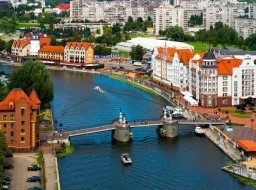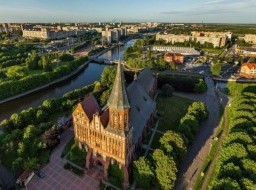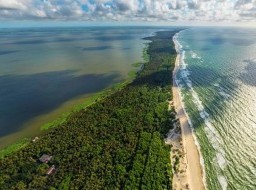Amber Museum
This art depository was inaugurated in 1979, to become Russia’s first and only Amber Museum. Located in the center of Kaliningrad on the Verkhneye Lake shore, it is housed in a fortress tower dating from the mid-nineteenth century. The tower was built in 1853 in the Neo-Gothic style as a part of the city defense system – its construction was supervised by Ernst Ludwig von Aster, commander of the Engineering Corps and the person, who had engineered Konigsberg’s mighty fortifications. The tower was named after the Prussian General-Field Marshal Friedrich Karl Dohna, who had participated in the liberation war against Napoleon’s invasion. The building is also a monument of the Second World War. The Amber Museum is a one-mineral treasury. The Museum exposition occupies three floors with a total space of 1,000 square meters. Thematically, it consists of two sections: one is devoted to science – natural history and geology and the other – to history and culture. Amber is fossilized resin of ancient conifers that grew more than 40 million years ago on the territory of modern south of the Scandinavian Peninsula and adjoining part of the Baltic Sea bed. In the scientific part of the exposition amber samples of different weight, colour, clarity are presented. In exposition are the biggest “sunstone” in Russia weighing 4.28 kilograms. The considerable part of the collection includes amber specimens with inclusions of animals and plant remains that were stuck in liquid viscous resin about millions years ago. The inclusions are the thing of great interest of scientist due to their variety and very good preservation. They are essential for specification our knowledge about flora and fauna of planet 40 – 45 million years ago. Today the collection of Kaliningrad amber museum is the main Russian national fund of Baltic amber inclusions. The section of culture and history presents amber adornments and household items from the Neolithic age (4000 – 2000 BC.) till nowadays. In museum there are artifacts found on Kaliningrad region territory while digging the monument of II-V centuries of AD that was the time of intensive trade contacts toward Rome Empire. There are a lot of raw amber in that time settlements. That amber was intended for sale, same time in the burial together with expensive adornments one or two amber beads could be find. The beads probably had sacral sense. Lost amber items of XVI century are presented by scientific reconstructions made by Kaliningrad masters and specialists of restoration workshop of Tsarskoye Selo.Of great value are the unique art works of masters of 17th century that were donated to the Museum by the Armoury of the Moscow Kremlin in 1978. They are also completed by the present-day copies of old amber masterpieces, re-created fragments of the famous Amber Room lost during the Second World War and some authentic items from the 19th – early 20th centuries made by Russian and European masters. A special expositional complex is dedicated to the Konigsberg State Amber Manufactory that had worked from 1926 to 1945. And Kaliningrad Amber Combine was opened in 1947, it is the only factory in the world with a full production cycle of amber extraction and treatment. The items of mass and author production from 1950 to 2000 could be found in exhibition halls. A large part of the Museum exposition consists of art works of contemporary artists from Russia, Germany, Denmark, France, Italy, Japan, Latvia, Lithuania, Poland, the USA. There are jewelry, sculptures and exclusive household items among them. Today Museum is one of the most interesting cultural places of the city. Its collection consists of more than 16 000 units of storage. Every year Museum is visited by 200 000 guests, 1 200 excursions are given, about more than 30 exhibitions are organized. One of the most important Museum activities is organization and holding of the International Biennial of Amber Art Works «Alatyr» (an Old Russian name of amber) since 2004, since 2012 – the All-Russian Jewelry Art Contest. Museum is actively engaged in publishing. 40 books have been published for the last eleven years. All the books are translated into English. In the museum, accessible environment is provided for people with limited health abilities. For people in wheelchairs, there is an elevating platform that brings them to the first floor of the building. The elevator is constructed considering technical capabilities of the museum and is set in the central stairwell. Doorways are equipped with threshold wheelchair ramps. A stairclimber with integrated seat (with lift detector) is used to go down to the basement level. It is possible to use a mobile telescopic wheelchair ramp to facilitate climbing up and down at the wheelchair along the area surrounding the museum. |







